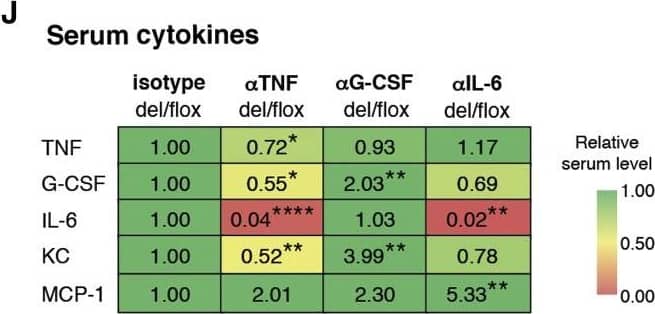Mouse G-CSF ELISA Kit - Quantikine
R&D Systems, part of Bio-Techne | Catalog # MCS00

Key Product Details
Assay Length
Sample Type & Volume Required Per Well
Sensitivity
Assay Range
Product Summary for Mouse G-CSF Quantikine ELISA Kit
Product Specifications
Assay Type
Format
Measurement
Detection Method
Conjugate
Reactivity
Specificity
Cross-reactivity
Interference
Precision
Intra-Assay Precision (Precision within an assay) Three samples of known concentration were tested on one plate to assess intra-assay precision.
Inter-Assay Precision (Precision between assays) Three samples of known concentration were tested in separate assays to assess inter-assay precision.
Cell Culture Supernates, Serum
| Intra-Assay Precision | Inter-Assay Precision | |||||
|---|---|---|---|---|---|---|
| Sample | 1 | 2 | 3 | 1 | 2 | 3 |
| n | 20 | 20 | 20 | 20 | 20 | 20 |
| Mean (pg/mL) | 64.4 | 196 | 697 | 64.8 | 195 | 620 |
| Standard Deviation | 2.3 | 8.8 | 43 | 4.1 | 15.5 | 50.6 |
| CV% | 3.6 | 4.5 | 6.2 | 6.3 | 7.9 | 8.2 |
Recovery for Mouse G-CSF Quantikine ELISA Kit
The recovery of mouse G-CSF spiked to three levels throughout the range of the assay in various matrices was evaluated.
| Sample Type | Average % Recovery | Range % |
|---|---|---|
| Cell Culture Supernates (n=7) | 92 | 82-110 |
| Serum (n=5) | 96 | 80-119 |
Linearity
To assess the linearity of the assay, five or more samples containing and/or spiked with various concentrations of mouse G-CSF in each matrix were diluted with Calibrator Diluent and then assayed.

Scientific Data Images for Mouse G-CSF Quantikine ELISA Kit
Mouse G-CSF ELISA Standard Curve
Detection of Mouse G-CSF by ELISA
Neutralization of TNF Ameliorates Inflammation Caused by OTULIN Deficiency(A–J) Measurements from tamoxifen (tx)-treated (arrows) CreERT2-Otulinflox bone marrow chimeras injected with (A–C) anti-TNF neutralizing antibodies ( alphaTNF) (data were pooled from two independent experiments), (D–F) anti-G-CSF-neutralizing antibodies ( alphaG-CSF), (G–I) anti-IL-6-neutralizing antibodies ( alphaIL-6), or isotype control as indicated.(A, D, and G) Body weight of CreERT2-Otulinflox chimeric mice treated with neutralizing antibodies as indicated.(B, E, and H) Blood neutrophil counts from CreERT2-Otulinflox chimeric mice treated as indicated.(C, F, and I) Total number of infiltrating CD11b+Gr-1+ neutrophils in spleen and peritoneal lavage (PL) measured by flow cytometry from CreERT2-Otulinflox chimeric mice treated as indicated.(J) Heatmap of Luminex multiplex analysis of cytokines and chemokines in serum from terminal bleeds on days 6 or 7 from chimeric mice treated as indicated. Numbers indicate relative change compared to isotype-treated del/flox mice within each experiment. G-CSF levels for alphaG-CSF and alphaIL-6 were measured by ELISA. Asterisks (∗) indicate the level of statistical significance.(K) Model of TNF-driven systemic inflammation and the contributions from different cytokines in OTULIN-deficient mice.(A–J) Data are presented as mean ± SEM, and n represents number of mice.See also Figure S3. Image collected and cropped by CiteAb from the following publication (https://pubmed.ncbi.nlm.nih.gov/27523608), licensed under a CC-BY license. Not internally tested by R&D Systems.Preparation and Storage
Shipping
Stability & Storage
Background: G-CSF
Long Name
Alternate Names
Gene Symbol
Additional G-CSF Products
Product Documents for Mouse G-CSF Quantikine ELISA Kit
Product Specific Notices for Mouse G-CSF Quantikine ELISA Kit
For research use only
⚠ WARNING: This product can expose you to chemicals including N,N-Dimethylforamide, which is known to the State of California to cause cancer. For more information, go to www.P65Warnings.ca.gov.

